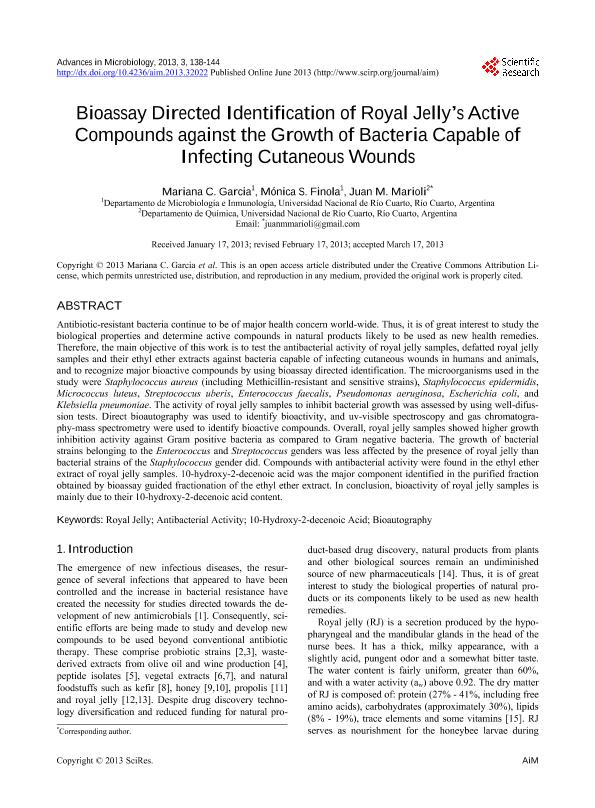Mostrar el registro sencillo del ítem
dc.contributor.author
Garcia, Mariana Celeste

dc.contributor.author
Finola, Mónica S.
dc.contributor.author
Marioli, Juan Miguel

dc.date.available
2017-08-22T17:56:30Z
dc.date.issued
2013-06
dc.identifier.citation
Garcia, Mariana Celeste; Finola, Mónica S.; Marioli, Juan Miguel; Bioassay directed identification of royal jelly’s active compounds against the growth of bacteria capable of infecting cutaneous wounds; Scientific Research Publishing; Advances in Microbiology; 3; 2; 6-2013; 138-144; 32336
dc.identifier.issn
2165-3402
dc.identifier.uri
http://hdl.handle.net/11336/22776
dc.description.abstract
Antibiotic-resistant bacteria continue to be of major health concern world-wide. Thus, it is of great interest to study the biological properties and determine active compounds in natural products likely to be used as new health remedies. Therefore, the main objective of this work is to test the antibacterial activity of royal jelly samples, defatted royal jelly samples and their ethyl ether extracts against bacteria capable of infecting cutaneous wounds in humans and animals, and to recognize major bioactive compounds by using bioassay directed identification. The microorganisms used in the study were Staphylococcus aureus (including Methicillin-resistant and sensitive strains), Staphylococcus epidermidis, Micrococcus luteus, Streptococcus uberis, Enterococcus faecalis, Pseudomonas aeruginosa, Escherichia coli, and Klebsiella pneumoniae. The activity of royal jelly samples to inhibit bacterial growth was assessed by using well-difussion tests. Direct bioautography was used to identify bioactivity, and uv-visible spectroscopy and gas chromatography-mass spectrometry were used to identify bioactive compounds. Overall, royal jelly samples showed higher growth inhibition activity against Gram positive bacteria as compared to Gram negative bacteria. The growth of bacterial strains belonging to the Enterococcus and Streptococcus genders was less affected by the presence of royal jelly than bacterial strains of the Staphylococcus gender did. Compounds with antibacterial activity were found in the ethyl ether extract of royal jelly samples. 10-hydroxy-2-decenoic acid was the major component identified in the purified fraction obtained by bioassay guided fractionation of the ethyl ether extract. In conclusion, bioactivity of royal jelly samples is mainly due to their 10-hydroxy-2-decenoic acid content.
dc.format
application/pdf
dc.language.iso
eng
dc.publisher
Scientific Research Publishing
dc.rights
info:eu-repo/semantics/openAccess
dc.rights.uri
https://creativecommons.org/licenses/by-nc-sa/2.5/ar/
dc.subject
Royal Jelly
dc.subject
Antibacterial Activity
dc.subject
10-Hydroxy 2-Decenoic Acid
dc.subject
Bioautography
dc.subject.classification
Bioquímica y Biología Molecular

dc.subject.classification
Ciencias Biológicas

dc.subject.classification
CIENCIAS NATURALES Y EXACTAS

dc.title
Bioassay directed identification of royal jelly’s active compounds against the growth of bacteria capable of infecting cutaneous wounds
dc.type
info:eu-repo/semantics/article
dc.type
info:ar-repo/semantics/artículo
dc.type
info:eu-repo/semantics/publishedVersion
dc.date.updated
2017-08-18T14:58:52Z
dc.journal.volume
3
dc.journal.number
2
dc.journal.pagination
138-144; 32336
dc.journal.pais
China

dc.description.fil
Fil: Garcia, Mariana Celeste. Universidad Nacional de Río Cuarto. Facultad de Ciencias Exactas, Fisicoquímicas y Naturales. Departamento de Microbiología e Inmunología; Argentina. Consejo Nacional de Investigaciones Científicas y Técnicas; Argentina
dc.description.fil
Fil: Finola, Mónica S.. Universidad Nacional de Río Cuarto. Facultad de Ciencias Exactas, Fisicoquímicas y Naturales. Departamento de Microbiología e Inmunología; Argentina
dc.description.fil
Fil: Marioli, Juan Miguel. Universidad Nacional de Río Cuarto. Facultad de Ciencias Exactas Fisicoquímicas y Naturales. Departamento de Química; Argentina. Consejo Nacional de Investigaciones Científicas y Técnicas; Argentina
dc.journal.title
Advances in Microbiology
dc.relation.alternativeid
info:eu-repo/semantics/altIdentifier/doi/http://dx.doi.org/10.4236/aim.2013.32022
dc.relation.alternativeid
info:eu-repo/semantics/altIdentifier/url/http://file.scirp.org/Html/2-2270152_32336.htm
Archivos asociados
